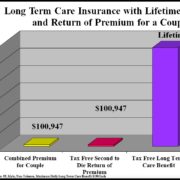Long Term Care Insurance Indemnity (Cash) Benefit – Long Term Care University – 06/15/09
Long Term Care University – Question of the Month – 06/15/09
Research
By Aaron Skloff, AIF, CFA, MBA
Q: Some of the long term care insurance policies I am researching allow for an indemnity benefit. Can you explain what that means and what advantages it may provide?
The Problem – Reimbursement Only Policies
Most long term care insurance policies are designed as reimbursement only. With a reimbursement only policy, upon submitting all of your receipts for long term care expenses the insurance company will reimburse you up to your policy’s limits. Unfortunately, you may have ancillary expenses associated with your long term care, including expenses to:
- add ramps and expand doorways throughout your home
- add additional railings to your staircases or add wheelchair lifts
- purchase or lease a van with a lift to get to and from your physician’s office
You may also want complete control over how you want to spend your long term care benefit, regardless of your actual expenses. That flexibility is not permitted with a reimbursement only policy.
The Solution – Indemnity Policies
Unlike reimbursement only policies, indemnity policies pay benefits above and beyond your actual long term care expenses. There are two basic types of indemnity policies, full and partial.
Full Indemnity Policy
With a full indemnity policy (sometimes called a flexible cash benefit or cash model), once you simply require long term care the insurance company pays you a monthly benefit. You receive these payments regardless of your actual expenses. Imagine your policy provides a $6,000 monthly benefit. Regardless of the amount or cost of your care, the insurance company will pay you $6,000 a month. You can pay an unlicensed family member or friend to care for you. You can payoff your mortgage. You can invest in your grandchild’s college fund. You can spend, save or invest the money however you choose.
Partial Indemnity Policy
With a partial indemnity policy (sometimes called a cash benefit or monthly indemnity benefit), once you actually receive at least one hour of long term care per day you receive a daily benefit. You receive these payments regardless of your actual expenses. Imagine your policy provides a $200 daily benefit. Regardless of the cost of your care, the insurance company will pay you $200 a day. You can spend, save or invest the money however you choose.
Getting the Most Out of Your Policy
Both full and partial indemnity polices address an underlying concern that you may have when you purchase a policy – you want the policy’s maximum benefit regardless of your actual expenses. With both types of polices the concern is eliminated.
Action Step – Protect Yourself with an Indemnity Policy
When you purchase an indemnity policy you protect yourself from unexpected expenses and gain the flexibility to spend, save or invest your money how you see fit.
Aaron Skloff, Accredited Investment Fiduciary (AIF), Chartered Financial Analyst (CFA) charter holder, Master of Business Administration (MBA), is the Chief Executive Officer of Skloff Financial Group, a NJ based Registered Investment Advisory firm. The firm specializes in financial planning and investment management services for high net worth individuals and benefits for small to middle sized companies. He can be contacted at www.skloff.com or 908-464-3060.











